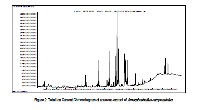Identification of Bioactive Components in Ethanolic and Aqueous Extracts of Amorphophallus campanulatus Tuber by GC-MS Analysis
Keywords:
Antioxidants, Medicinal plant, Oxidative stress, PhytochemistryAbstract
The uses of herbal medicines worldwide provide an excellent opportunity for India to look into the therapeutic compounds from ancient system of therapy, Ayurveda. Since ancient time, Amorphophallus campanulatus has been considered as medicinal plant with multiple protective activities. So, the present study was aimed to identify the various phytochemical constituents in the ethanolic and aqueous extracts of Amorphophallus campanulatus tuber by GC-MS analysis. The ethanolic and aqueous extracts of Amorphophallus campanulatus were dissolved in absolute ethanol (1mg/ml). 10µl of this sample was then injected for gas chromatography- mass spectrometric (GC-MS) analysis. The results for the first time revealed the presence of several bioactive components both in the ethanolic as well as in the aqueous extracts. However, the ethanolic extract showed quantitatively higher amount of these components than the aqueous extract as is clearly indicated by higher % peak area of the compounds in the ethanolic extract. Some components of biological importance include Hexadecanoic acid and its methyl and ethyl esters, Heptadecanoic acid, Linoleic acid and its ester, Oleic acid, Stigmasterol, 1, 3, 5, benzenetriol, 4H-Pyran-4-one, 2, 3-dihydro-3, 5 -dihydroxy-6-methyl-, Squalene and Vitamin E. Thus the results of the present study is an evidence to support the traditional usage of A. campanulatus which possess several known and unknown bioactive components. By identifying and isolating these components, new drugs can be formulated to treat various diseases.
References
. Kalaivani CS, Sahaya SS, Janakiraman
N, Johnson M. GC-MS Studies on
Andrographis paniculata (Burm.f.) Wall.
ex Nees ă A medicinally important plant.
Int. J. Med. Arom. Plants. 2012; 2(1): 69-
. Mukherjee PK. Quality Control of Herbal
Drugs. In: Business Horizons
Pharmaceutical Publishers; 2008. p.
-358.
. Sangeetha J, Vijayalakshmi K.
Determination of bioactive components
of ethyl acetate fraction of Punica
granatum Rind extract. IJPSDR. 2011;
(2): 116-122.
. Vohra A, Kaur H. Chemical investigation
of medicinal plant Ajuga bracteosa.
; J. Nat. Prod. Plant. Resour. 2011;
(1): 37-45.
. Wu L, Gao H, Wang X, Ye J, Lu J, Liang
Y. Analysis of chemical composition of
Chrysanthamum indicum flowers by
GC/MS and HPLC. JMPR. 2010; 4(5):
-426.
. Perumal SR, Gopalakrishnakone P.
Current status of herbal and their future
perspectives. Nature Proceedings. 2007;
: 1176-1188.
. Khare CP. Encyclopedia of Indian
Medicinal Plants, Rational Western
Therapy, Ayurvedic and other Traditional
Uses. In: Botany. Berlin: SpringerVerlag; 2004. p. 55.
. Patel K, Gupta M, Page A. Evaluation of
analgesic and anti-inflammatory activity
of methanolic extract of Amorphophallus
campanulatus tuber by carrageenan
induced paw oedema and hot plate
method. JAPHR. 2011; 1: 31-36.
. Khan A, Rahman M, Islam MS.
Antibacterial, antifungal and cytotoxic
activities of 3, 5- diacetyltambulin
isolated from Amorphophallus
campanulatus Blume ex. Decne. DARU.
; 16(4): 239-244.
. J. Angayarkanni, K.M. Ramkumar, T.
Poornima and U. Priyadarshini.
Cytotoxic activity of Amorphophallus
paeoniifolius tuber extracts in vitro.
American-Eurasian J. Agric. &
Environ.Sci. 2007 ; 2(4): 395-398.
. Basu S, Das M, Datta G. Phytochemical
evaluation and study of in vitro
antioxidant potential of ethanolic and
aqueous extracts of Amorphophallus
campanulatus: a popular tuber of West
Bengal. Int. J. Res. Pharm. Sci. 2012;
(2): 287-295.
. Firdouse S, Alam P. Phytochemical
investigation of extract of
Amorphophallus campanulatus tubers.
International Journal of Phytomedicine.
; 3: 32-35.
. Kumoro AC, Hasan M, Singh H. Effects
of solvent properties on the Soxhlet
extraction of diterpenoid lactones from
Andrographis paniculata leaves. Science
Asia. 2009; 35: 306-309.
. Merlin NJ, Parthasarathy V, Manavalan
R, Kumaravel S. Chemical Investigation
of Aerial Parts of Gmelina asiatica Linn
by GC-MS, Pharmacognosy Res. 2009;
(3): 152-156.
. Jim Duke, DukeÊs ethanobotanical and
phytochemistry database,
www.arsgrin.gov/duke/, 1998.
. Chew YL, Goh JK, Lim YY. Assessment
of in vitro antioxidant capacity and
polyphenolic composition of selected
medicinal herbs from Leguminosae
family in Peninsular Malaysia. Food
Chemistry. 2009; 6: 13-18.
. Rice-Evans CA, Miller NJ, Paganga G.
Structure-antioxidant activity
relationships of flavanoids and phenolic
acids. Free Radical Biology and
Medicine. 1996; 20: 933-956.



